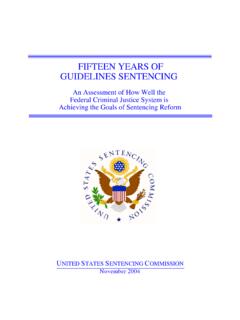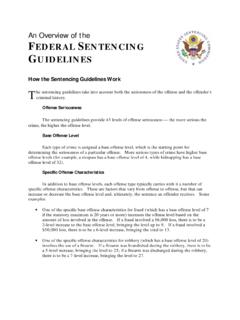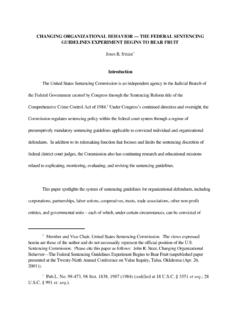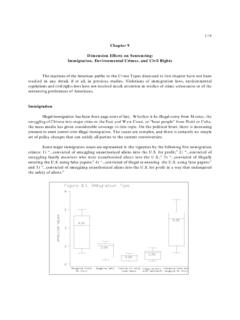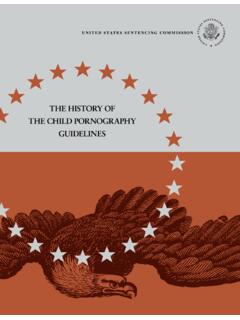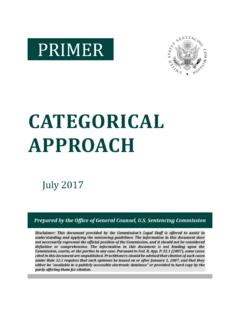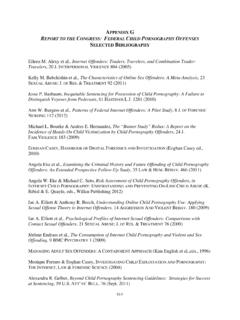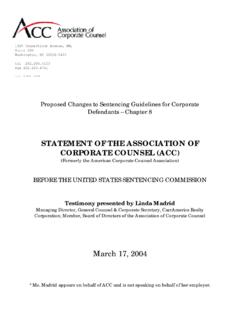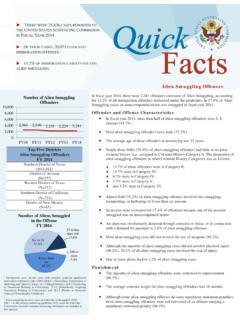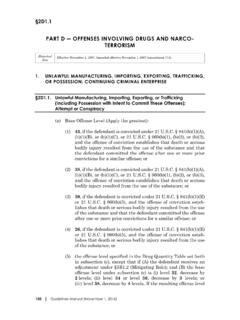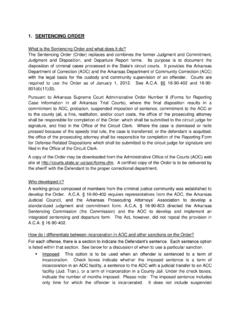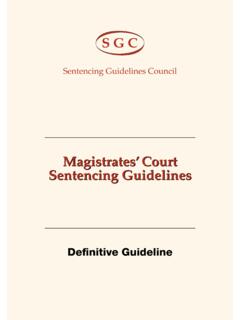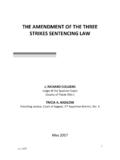Transcription of Primer on Drug Guidelines - United States Sentencing ...
1 Primer drug Guidelines March 2020 Prepared by the Office of General Counsel, Sentencing Commission Disclaimer: This document is intended to assist in understanding and applying the Sentencing Guidelines . The information in this document should not be considered definitive or comprehensive. In addition, the information in this document does not represent an official Commission position on any particular issue or case, and it is not binding on the Commission, the courts, or the parties in any case. To the extent this document includes unpublished cases, practitioners should be cognizant of Fed. R. App. P. , as well as any corresponding rules in their jurisdictions. P r i m e r o n t h e D r u g G u i d e l i n e s ii TABLE OF CONTENTS I. INTRODUCTION .. 1 II. drug STATUTES .. 1 A. THE STATUTORY SCHEME .. 1 B. LEGAL ISSUES.
2 2 1. Aggregating Quantity .. 2 2. Enhanced Penalties .. 3 C. LESSER OFFENSES .. 4 III. CHAPTER TWO OFFENSE GUIDELINE SECTIONS .. 4 A. APPLICABLE OFFENSE GUIDELINE SECTION IS DRIVEN BY OFFENSE OF CONVICTION .. 4 B. SECTION (UNLAWFUL MANUFACTURING, IMPORTING, EXPORTING, OR TRAFFICKING (INCLUDING POSSESSION WITH INTENT TO COMMIT THESE OFFENSES); ATTEMPT OR CONSPIRACY) .. 5 1. Determining the Base Offense Level .. 5 2. drug Type .. 8 3. drug Quantity .. 13 C. SELECTED SPECIFIC OFFENSE CHARACTERISTICS .. 21 1. Section (b)(1) .. 21 2. Section (b)(2) .. 24 3. Section (b)(5) .. 24 4. Section (b)(7) .. 24 5. Section (b)(11) .. 25 6. Section (b)(12) .. 25 7. Section (b)(13) .. 25 8. Section (b)(14) .. 26 9. Section (b)(15) .. 26 10. Section (b)(16) .. 26 11. Section (b)(17) .. 27 12. Section (b)(18) .. 27 D. CROSS REFERENCES .. 27 1. Murder .. 27 2. Crime of Violence .. 27 E. APPLICATION ISSUES FOR SPECIFIC DRUGS.
3 28 1. Cocaine .. 28 2. 29 3. Methamphetamine .. 30 4. LSD .. 32 P r i m e r o n t h e D r u g G u i d e l i n e s iii IV. OTHER OFFENSE GUIDELINE SECTIONS .. 32 A. SECTION ( drug OFFENSES OCCURRING NEAR PROTECTED LOCATIONS OR INVOLVING UNDERAGE OR PREGNANT INDIVIDUALS; ATTEMPT OR CONSPIRACY) .. 32 B. SECTION (RENTING OR MANAGING A drug ESTABLISHMENT; ATTEMPT OR CONSPIRACY) .. 33 C. SECTION (ENDANGERING HUMAN LIFE WHILE ILLEGALLY MANUFACTURING A CONTROLLED SUBSTANCE; ATTEMPT OR CONSPIRACY) .. 33 D. SECTION (UNLAWFULLY DISTRIBUTING, IMPORTING OR POSSESSING A LISTED CHEMICAL; ATTEMPT OR CONSPIRACY) .. 34 E. SECTION (UNLAWFUL POSSESSION, MANUFACTURE, DISTRIBUTION, TRANSPORTATION, EXPORTATION, OR IMPORTATION OF PROHIBITED FLASK, EQUIPMENT, CHEMICAL, PRODUCT, OR MATERIAL; ATTEMPT OR CONSPIRACY) .. 36 F. SECTION (UNLAWFUL POSSESSION; ATTEMPT OR CONSPIRACY).. 36 V. SELECTED RELEVANT CONDUCT ISSUES SPECIFIC TO drug CASES.
4 36 A. REASONABLE FORESEEABILITY AND RELEVANT CONDUCT .. 36 B. PRIOR CONVICTIONS AND RELEVANT CONDUCT .. 37 C. BASE OFFENSE LEVELS IF DEATH RESULTS .. 38 D. PERSONAL USE QUANTITIES AND RELEVANT CONDUCT .. 39 VI. Sentencing MANIPULATION/ENTRAPMENT .. 40 A. Guidelines REMEDIES FOR Sentencing MANIPULATION/ENTRAPMENT .. 40 1. Application Note 5 to .. 40 2. Application Note 27(A) to .. 40 B. OTHER Sentencing MANIPULATION/ENTRAPMENT .. 41 C. LIMITS ON Sentencing MANIPULATION/ENTRAPMENT .. 42 VII. CHAPTER THREE: ADJUSTMENTS .. 42 A. ROLE ADJUSTMENTS .. 42 B. ABUSE OF POSITION OF TRUST OR USE OF A SPECIAL SKILL .. 42 C. USING A MINOR TO COMMIT A CRIME .. 43 1. Section - "Using" of Minor to Commit Crime .. 43 2. Section - Use of Minor and Defendant's Age .. 44 VIII. CHAPTER FOUR: CRIMINAL HISTORY, CAREER OFFENDER, AND ARMED CAREER CRIMINAL (ACCA) .. 44 P r i m e r o n t h e D r u g G u i d e l i n e s iv IX.
5 CHAPTER FIVE: DETERMINING THE SENTENCE .. 46 A. STATUTORY PENALTY RANGES REVISITED: APPRENDI .. 46 1. Statutory Maximum Sentence .. 46 2. Statutory Mandatory Minimum Sentences .. 47 B. RELIEF FROM MANDATORY MINIMUM SENTENCES: THE "SAFETY VALVE" .. 48 1. The Statutory and Guideline Conditions .. 49 2. Section (b) .. 53 3. Safety Valve and (b)(17).. 53 4. Safety Valve and Departures/Variances .. 53 C. DOWNWARD DEPARTURES FOR SUBSTANTIAL ASSISTANCE TO AUTHORITIES: .. 53 X. CHAPTER SIX: Sentencing PROCEDURES AND PLEA AGREEMENTS .. 54 A. PLEA AGREEMENT CONSIDERATIONS .. 54 1. Agreement to Not Pursue Further Charges .. 54 2. Agreement as to Sentence Recommendation .. 54 3. Agreement as to Sentence to be 55 4. Withdrawal of Plea .. 55 B. THE Guidelines ' TREATMENT OF PLEA AGREEMENTS .. 55 1. Policy 55 2. Section (Plea Agreement Procedure (Policy Statement)) .. 55 3. Guideline Standards for Accepting Plea Agreement.
6 55 C. SECTION (USE OF CERTAIN INFORMATION) .. 56 P r i m e r o n t h e D r u g G u i d e l i n e s 1 I. INTRODUCTION This Primer is intended to provide a general overview of the statutes, Sentencing Guidelines , and relevant case law relating to drug trafficking. This Primer focuses primarily on application of the drug trafficking Guidelines and related Sentencing issues. Although the Primer identifies some of the issues and cases related to the Sentencing of drug trafficking offenses, it is not a comprehensive compilation of case law and is not intended to be a substitute for independent research and analysis of primary II. drug STATUTES A. THE STATUTORY SCHEME The most commonly used drug statutes include the following: 21 841 Prohibits the manufacture and distribution of, and possession with intent to distribute, controlled substances 21 846 Prohibits attempts and conspiracies to manufacture, distribute or possess with intent to distribute controlled substances 21 952 Prohibits the importation of controlled substances 21 953 Prohibits the exportation of controlled substances 21 963 Prohibits attempts and conspiracies to import/export controlled substances The penalty structures for these and other drug crimes are set out in 21 841(b) and 960(b).
7 The minimum and maximum statutory penalties are driven by the type and the quantity of the drug involved, but may be increased if the offense involved death or serious bodily injury, or if the offender has a prior conviction for a felony drug offense. For example: Pursuant to 21 841(b)(1)(A) and 960(b)(1), a statutory range of ten years to life applies to offenses involving at least: 1 Detailed materials on the Commission s 2014 drug Guidelines amendment that reduced Sentencing guideline penalties for most federal drug trafficking offenders by two levels are available at http://www. In addition, a detailed discussion of retroactivity, including issues related to the Fair Sentencing Act and the Supreme Court s decisions in Dorsey v. United States , 567 260 (2012), and Dillon v. United States , 560 817 (2010), is presented in the Commission s subject matter Primer on Retroactivity, available at Guidelines /primers.
8 P r i m e r o n t h e D r u g G u i d e l i n e s 2 1 kilogram of Heroin 5 kilograms of Cocaine (powder) 280 grams of Cocaine base 1,000 kilograms of Marijuana or 1,000 plants 50 grams of actual Methamphetamine or 500 grams of mixture or substance Pursuant to 21 841(b)(1)(B) and 960(b)(2), a statutory range of 5 to 40 years applies to offenses involving at least: 100 grams of Heroin 500 grams of Cocaine (powder) 28 grams of Cocaine base 100 kilograms of Marijuana or 100 plants 5 grams of actual Methamphetamine or 50 grams of mixture or substance Pursuant to 21 841(b)(1)(C) and 960(b)(3), a statutory range of 0 to 20 years applies to offenses involving lesser quantities of drugs. A statutory maximum of five years is provided for offenses involving less than 50 kilograms of marijuana and for certain other lesser offenses. See 21 841(b)(1)(D) and 960(b)(4). B. LEGAL ISSUES 1. Aggregating Quantity drug amounts should not be aggregated to apply a higher statutory penalty range than any of the individual substantive counts would support.
9 That is, where the defendant is convicted of separate substantive counts, the drug amounts are not added together to reach a mandatory minimum sentence. United States v. Harrison, 241 289, 292 (2d Cir. 2001) (noting drug quantities from separate transactions are not aggregated for purposes of calculating a mandatory minimum, but the combined quantities are relevant under to establish the base offense level); United States v. Rettelle, 165 489, 492 (6th Cir. 1999) (holding that it was error to construe the statutory penalty as applying to aggregate amounts of drugs held manufactured on various separate occasions); United States v. Santos, 195 549, 553 (10th Cir. 1999); United States v. Rodriguez, 67 1312, 1324 (7th Cir. 1995); United States v. Estrada, 42 228, 232 (4th Cir. 1994). In a conspiracy conviction, however, the quantities of each single type of drug charged within the conspiracy are aggregated to establish statutory penalties.
10 See, , United States v. Pressley, 469 63, 66 (2d Cir. 2006); United States v. Gori, 324 234, 237 (3d Cir. 2003). Note, however, that uncharged drug quantities are not included to establish statutory penalties. See Alaniz v. United States , 351 365, 368 (8th Cir. 2003) (reviewing 28 2255 challenge to conspiracy to distribute marijuana conviction and P r i m e r o n t h e D r u g G u i d e l i n e s 3 explaining that [e]very circuit that has considered the issue has concluded that a second, uncharged drug type cannot be added to the charged drug type in order to trigger a higher statutory penalty range. ). 2. Enhanced Penalties Sections 841(b) and 960(b) include enhancement provisions based on the defendant s prior record, which apply only if the government provides notice pursuant to 21 851 (proceedings to establish previous convictions). A qualifying prior conviction increases a 5- to 40-year range to a range of ten years to life.
